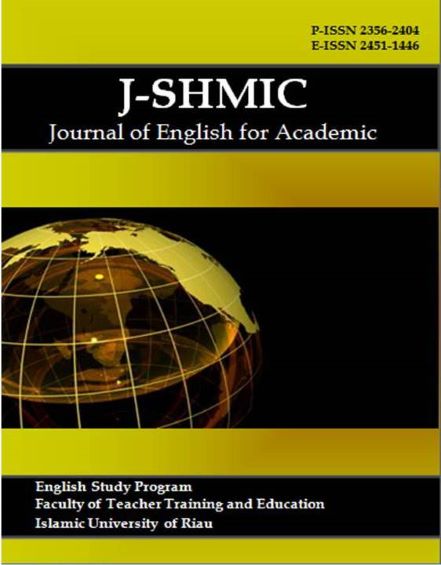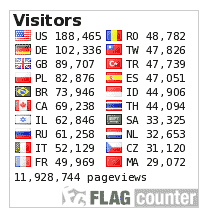Mind Mapping-Enhanced Reading Comprehension to Indonesia Islamic Junior High School Students: An Action Research
Keywords:
Reading comprehension, mind mapping technique, descriptive textAbstract
This classroom action research was conducted in a State Islamic Junior High School in Tanjung Pinang at the 8th grade in academic year 2020-2021. The purpose of the research was to describe how mind mapping can improve students’ reading comprehension of descriptive texts. The participants of the research consisted of 27 students. To gather the research data, the researchers used observation and test. The test was administered three times (pre-test, post-test 1, and post-test 2). Then, the data got from the observation were analyzed qualitatively while those from test were analyzed quantitatively. The result of pre-test was 9 students (33,3%) scored ≥70. In the post-test first cycle, the score of 16 students (59,25%) was ≥70, and in the post-test cycle II, 20 students (74,1%) scored ≥70. The results of the tests showed that the number of students who got score ≥70 improved. Meanwhile, the result of the observation showed that the use of mind mapping was successful in improving students’ reading comprehension. The students became more interested and more motivated to learn. It showed that ≥70% of the students participated actively in the teaching and learning process. Therefore, it is recommended for teachers to use this technique to upgrade students’ learning achievement.
Downloads
References
Al-Otaibi, W. H. (2016). The Effectiveness of Non-Hierarchal Electronic Mind Maps Strategy in Developing Visual Thinking Skills in the Course of Science among Primary Stage Female Students. Journal of Educational and Psychological Sciences, 17(2), 117–143.
Arikunto, S. (2009). Penelitian Tindakan Kelas. Jakarta: PT. Bumi Aksara.
Butt, D., Fahey, R., Feez, S., Spinks, S., & Yallop, C. (2000). Using Functional Grammar: An Explorer’s Guide (2 nd). Sidney.
Buzan, T. (2016). Buku Pintar Mind Map. Jakarta: PT. Gramedia Pustaka Utama.
Derewianka, B. (1990). Exploring How Text Work. Australia: Primary English Teaching Association.
Emilia, E., & Christie, F. (2013). Factual Genres in English: Learning to Write, Read, and Talk about Factual Information. Bandung: Rizqi Press.
Gerot, L., & Wignel, P. (1994). Making Sense of Functional Grammar. NSW: Antipodean Educational Enterprise.
Griffiths, C. (2020). How Mind Mapping Boosts Your Creativity. Retrieved from https://innovationmanagement.se/2020/05/22/how-mind-mapping-boosts-your-creativity/
Hariyadi, S., Corebima, A., & Ibrohim, S. Z. (2018). Contribution of Mind Mapping, Summarizing, and Questioning in the RQA Learning Model to Genetic Learning Outcomes. Journal of Turkish Science Education, 15(1), 80–88.
Jones, B. D., Ruff, C., Snyder, J. D., Petrich, B., & Koonce, C. (2012). The Effects of Mind Mapping Activities onStudents’ Motivation. International Journal for the Scholarship ofTeaching and Learning, 6(1), 1–21.
Kalyanasundaram, M., Abraham, S. B., Ramachandran, D., Jayaseelan, V., Bazroy, J., Singh, Z., & Purty, A. J. (2017). Effectiveness of Mind Mapping Technique in Information Retrieval Among Medical College Students in Puducherry-A Pilot Study. Indian Journal of Community Medicine, 42(1), 19–23.
Keraf, G. (2000). Eksposisi dan Deskriptive. Jakarta: Gramedia.
Kernan, W. D., Basch, C. H., & Cadorett, V. (2018). Using Mind Mapping to Identify Research Topics: A Lesson for Teaching Research Methods. Pedagpgy in Health Promotion, 4(2), 101–107.
Knapp, P., & Watkins, M. (2005). Genre, Text, Grammar. Sidney: University of New South Wales Press Ltd.
Kulsum, N. U. (2018). Mind Mapping Model in Increasing Students’ Creativity and Learning Outcomes. Classroom Action Research Journal, 2(3), 127–132.
Meier, P. S. (2007). Mind-mapping-A Tool for eliciting and Representing Knowledge Held by Diverse Informants. Guildford: University of Survey.
Menteri Pendidikan dan Kebudayaan Indonesia. Tentang Perubahan atas Peraturan Menteri Pendidikan dan Kebudayaan Nomor 24 Tahun 2016 Tentang Kompetensi Inti dan Kompetensi Dasar Pelajaran pada Kurikulum 2013 Pada Pendidikan Dasar dan Pendidikan Menengah, Pub. L. No. 37, 294 (2018). Indonesia.
Nafisah, N., & Kurniawan, E. (2007). Writing: English for General Communication. Bandung: UPI Press.
Presnyakova, I. (2011). Systemic Functional Analysis of Elementary School Language Arts Textbooks. Unpublished Thesis, College of Liberal Arts.
Purwoko, S. (2013). Buku PIntar Mind Map. Jakarta: Gramedia Pustaka Utama.
Silabus SMP/ MTS. (2019). Tanjungpinang.
Suyanto, A. (2015). The Effectiveness of Mind-Mapping in Improving Students’ Writing Skill Viewed from Their IQ. Indonesian Journal of English Education (IJEE), 2(2), 101–119.
Wilson, K., Copeland-Solas, E., & Guthrie-Dixon, N. (2016). A Preliminary Study on theuse of Mind Mappingas a Visual-Learning Strategy in General Education Science classesfor Arabicspeakersin the United Arab Emirates. Journal of the Scholarship of Teaching and Learning, 16(1), 31–52.
Published
How to Cite
Issue
Section
This is an open-access article distributed under the terms of the Creative Commons Attribution-ShareAlike 4.0 International License which permits unrestricted use, distribution, and reproduction in any medium. Users are allowed to read, download, copy, distribute, search, or link to full-text articles in this journal without asking by giving appropriate credit, providing a link to the license, and indicating if changes were made. All of the remixes, transform, or build upon the material must distribute the contributions under the same license as the original.











